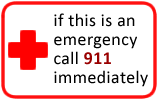Hay Fever (Nasal Allergies)
Hay Fever (Nasal Allergies)
Does this describe your child's symptoms? |
Definition
Symptoms
Causes
|
If not, see these topics
|
When to Call Your Doctor |
Call Your Doctor Within 24 Hours (between 9 am and 4 pm) If |
|
|
|
Call Your Doctor During Weekday Office Hours If |
|
|
|
Parent Care at Home If |
|
|
HOME CARE ADVICE FOR HAY FEVER |
Reassurance:
Hay fever is very common, occurring in 15% of children.
Nose and eye symptoms can be brought under control by giving antihistamines.
Because pollens are in the air every day during pollen season, antihistamines must be given daily for 2 months or longer.
Antihistamines:
Antihistamines are the drug of choice for nasal allergies.
Antihistamines will reduce the runny nose, nasal itching and sneezing.
Benadryl or Chlorpheniramine (CTM) products are very effective and no prescription is needed. They need to be given every 6 to 8 hours (See Dosage table).
The bedtime dosage is especially important for healing the lining of the nose.
The key to hay fever control is to give antihistamines every day during pollen season.
Cetirizine (Zyrtec) or Loratadine (Claritin):
Loratadine and Cetirizine are nonprescription, long-acting antihistamines.
Advantage: causes less sedation than older antihistamines (Benadryl and chlorpheniramine) AND is long-acting ( lasts up to 24 hours).
Dosage:
AGE 2- 6 years old, discuss with your child's doctor. If approved, give 2.5 mg (2.5 ml or 1/2 teaspoon) of liquid syrup once daily in the morning.
AGE 6-12 years old, give 5 mg chewable tablet once daily in morning.
AGE: 12 years and older, give 10 mg tablet once daily in morning.
Indication: Drowsiness from older antihistamines interferes with function
Limitation: doesn't control hay fever symptoms as well as older antihistamines. Also, occasionally will have breakthrough symptoms before 24 hours.
Cost: ask pharmacist for store brand. (Reason: costs less than Claritin or Zyrtec brand)
Nasal Washes to Wash Out Pollen:
Use saline nose drops or spray to wash out pollen or to loosen up dried mucus. If not available, can use warm tap water. Teens can just splash warm tap water in the nose and then blow.
STEP 1: Instill 3 drops per nostril.
STEP 2: Blow each nostril separately while closing off the other nostril. Then do other side.
STEP 3: Repeat nose drops and blowing until the discharge is clear.
Frequency: Do nasal washes whenever your child can't breathe through the nose or it's very itchy.
Saline nasal sprays can be purchased without a prescription.
Saline nose drops can also be made: add 1/2 tsp (2 ml) of table salt to 1 cup (8 ounces or 240ml) of warm water.
Another option: use a warm shower to loosen mucus. Breathe in the moist air, then blow each nostril.
Eye Allergies:
For eye symptoms, wash the pollen or other allergic substance off the face and eyelids.
Then apply cold compresses.
Usually an oral antihistamine will adequately control the eye allergy symptoms, but sometimes eyedrops are also needed.
Antihistamine Eyedrops - Ketotifen (1st Choice):
Ketotifen eyedrops are a safe and effective product (e.g., Zaditor or Alaway) (no prescription needed).
Dosage: 1 drop every 12 hours
For severe allergies, the continuous use of ketotifen eyedrops on a daily basis during pollen season will give the best control.
Antihistamine/Vasoconstrictive Eyedrops (2nd Choice):
Dosage: 1 drop every 8 hours
Ask your pharmacist to recommend a brand. (e.g. Naphcon A, Opcon A, Visine A)
Disadvantage: less effective than Ketotifen eye drops.
Wash Pollen Off Body:
Remove pollen from the hair and skin with hair washing and a shower, especially before bedtime.
Expected Course: Since pollen allergies recur each year, learn to control the symptoms.
Pollen Avoidance:
Pollen is carried in the air
Keep windows closed in the home, at least in child's bedroom
Keep windows closed in car, turn AC on recirculate
Avoid window fans or attic fans
Try to stay indoors on windy days (Reason: the pollen count is much higher when it's dry and windy)
Avoid playing with outdoor dog (Reason: pollen collects in the fur)
Pollen Count: You can get your daily pollen count from www.pollen.com.Just type in your zip code.
Call Your Doctor If:
Symptoms aren't controlled in 2 days with continuous antihistamines
Your child becomes worse
And remember, contact your doctor if your child develops any of the "Call Your Doctor" symptoms.
Updated:
March 22, 2017



